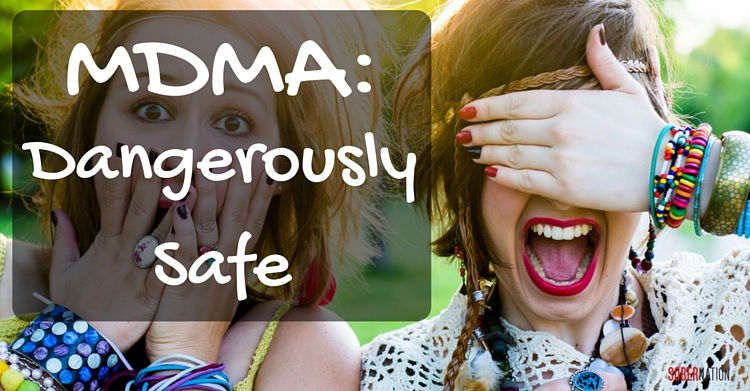May 19, 2016 | By Nadia Sheikh
MDMA: Dangerously Safe
Addiction & Recovery News Addiction Resources Ecstasy Addiction Mental Health
MDMA gained massive popularity in the 1980s & ‘90s—a raving, rolling time of all-night dance parties and electronic music. E symbolized euphoria, energy, love, escape.
As demand for the drug increased, it was sold on the street cut with all kinds of substances—methamphetamine, ketamine, cocaine, PCP—and Ecstasy’s reputation had soured by the new millennium. Some social reformers began to call the drug “Agony” because of its reportedly terrible health affects, supposedly putting holes in our brains and turning them into Swiss cheese.
Within the last 15 years, MDMA has returned as Molly—a powder or crystalline form of MDMA that’s supposed to be pure and more safe. With Molly’s feel-good effects, supposed “purity,” and growing research about its potential therapeutic value, MDMA has started to gain social acceptability.
Over the past 5 years, MDMA use has remained steady among teens and young adults. More surprisingly, MDMA use has also been steady among adults aged 26 and older, and the majority of these adult users have attended college and have full-time employment. Is there a future for MDMA in the medical world? And what are the risks you take when someone sells you “Molly?”
What is MDMA?
MDMA is a stimulant, also referred to as Ecstasy, E, Beans, the Love Drug, X, and Disco Biscuit. It often comes in colorful tablets and pills, as well as powder form, capsules, and liquid. The drug is an amphetamine derivative, structurally similar to the stimulant methamphetamine and the hallucinogen mescaline, with a wide range of effects:
- Intense, prolonged surge of energy
- Enhanced tactile experiences and sensory perception
- Distortions in time
- Reduced inhibitions, decreased anxiety
- Feelings of euphoria, general sense of well-being
- Feeling of closeness and empathy
- Heightened sexuality
Within an hour of ingesting the drug, the brain releases a trio of powerful neurotransmitters: serotonin, dopamine, and norepinephrine. In combination, these bring a surge of pleasure that’s both emotional and physical. Some equate rolling on MDMA to a “spiritual experience.” The serotonin, in particular, elevates mood, decreases pain and appetite, and increases energy.
The Come-Down and Overdose
This surge in neurotransmitters eventually wanes, and this makes the come-down a tricky time:
- Anxiety
- Restlessness
- Irritability
- Aggression
- Depression, as serotonin levels drop dramatically
MDMA can reduce the pumping efficiency of the heart, dehydrates the body, and is hard for the body to metabolize, all increasing the potential for toxic levels in the blood stream and overdose:
- Muscle cramping and tension
- Jaw clenching
- Tremors
- Blurred vision
- Faintness, loss of consciousness
- Elevated heart rate and blood pressure
- Hyperthermia, significant increase in body temperature which typically requires medical attention
- Leads to dehydration, muscle breakdown, kidney failure, heart failure.
History of MDMA in Medicine
Therapists in the U.S. and Switzerland began experimenting with MDMA from 1970-1985 as a prescription drug to enhance the effectiveness of psychotherapy in counseling sessions, particularly couples therapy. in 1976, psychedelic researcher Alexander Shulgin made MDMA in his lab. When Shulgin ran his first experiment with the drug on himself (of course), he reported, “I feel absolutely clean inside, and there is nothing but pure euphoria.”
Leo Zeff, pioneer of psychedelic therapy, called it “penicillin for the soul,” because he believed the drug has the power to return patients to a state of uncorrupted consciousness. Reports from this time suggested that it could be useful in treating trauma-related disorders.
In 1985, the DEA placed MDMA in the Schedule I category of the Controlled Substance Act. This declared the drug illegal, with no accepted medical use and a high potential for abuse. Yet, thousands of practitioners in psychology and psychotherapy continued to run underground clinical trials with MDMA. Why?
Therapeutic Value
In 2015 there were several clinical studies that used MDMA in psychotherapy sessions with chronic, treatment-resistant Post-Traumatic Stress Disorder patients. Patients would ingest between 75-188 mg of MDMA during select sessions and were guided in a therapy session with music and nurturing touches.
These treatment professionals do not consider the drug a medication for PTSD by any means. MDMA is considered a catalyst to psychotherapy, allowing patients to break down emotional barriers, enhance communication skills, and promote deep introspection.
MDMA makes patients feel good with huge surges or serotonin and dopamine, along with oxytocin, the hormone of bonding, trust, and intimacy. The greatest issue with PTSD patients is avoidance of their trauma in an attempt to protect themselves emotionally. But, in MDMA-assisted therapy, “they feel calm enough and their fear is extinguished enough that they can actually process the trauma,” says psychiatrist Dr. Julie Holland.
MRI brain scans show that MDMA decreases activity in the amygdala, the brain’s fear center, and increases activity in the prefrontal cortex, associated with memory and higher functioning. Researchers believe this allows people to understand a trauma, revisiting old trigger memories and painful emotions, without being overwhelmed.
Patients who have been through MDMA-assisted psychotherapy sessions report moments of epiphany and revelation, discovering “that my perception and reality were not always the same.” Many clients felt that the drug produced an objective state in which they could revisit their most difficult emotions. Much like the philosophy behind EMDR, MDMA-assisted therapy aims to allow people to revisit trauma by standing outside of their experience with it.
Many of the patients from the studies credit their MDMA-assisted therapy with freeing them of their crippling fear and thoughts of suicide, allowing them to make progress that they never imagined they could make. MDMA may also be potentially useful for victims of abuse, rape survivors, or people with eating disorders, ideally allowing them to experience comfort in their own skin.
Some scientists see MDMA as a gateway to creating a better drug, harnessing the euphoria and heightened sensory input but leaving behind the intoxicating effects like the accelerated heart rate and hyperthermia. Others consider MDMA a damaging solution for PTSD patients—yes, the drug can be monitored and administered carefully, but there is also concern over presenting patients with a seemingly “magical” solution. Research has shown that hard work in psychological treatment without drug assistance is more satisfying and long-lasting for a patient.
What’s Molly?
So the term Molly is now associated with this idea of pure MDMA, different from the Ecstasy of the ‘90s, with potential therapeutic value that’s been researched. How can it be bad?
In the past, studies reported that MDMA causes Parkinson’s disease, holes in the brain, and permanent serotonin damage leading to lifelong depression. Modern studies, however, have found no evidence that MDMA impairs cognitive performance, nor any evidence that clinical usage—a few moderate doses of pure MDMA under medical supervision—leads to any of these damages.
But, let’s be honest: how many people who use MDMA are taking only a few controlled doses under medical supervision? Beyond that, how many of us who have taken Molly, Ecstasy, or “MDMA” actually had a healthy dose of the pure, pharmaceutical-grade drug?
The Drug Abuse Warning Network reported that MDMA-related emergency-room visits have doubled since 2004. If it’s so pure and safe, then why? According to psychologist Dr. John Halpern, an advocate for MDMA-assisted therapy, most powders sold as Molly don’t contain any MDMA whatsoever. In 2013, only 9 percent of the “Molly” that the DEA collected in the state of New York contained the pure form of MDMA.
Most of my experiences with MDMA involved heavy doses, sometimes multiple doses, and I was far from any kind of medical supervision or help if I needed it. Even if I was one of the rare few who came across pure MDMA, taking the drug in a nonmedical setting, especially at a club or a concert, is a huge risk—elevated blood pressure and heart rate, dehydration, hyperthermia, failure of major organs.
So Why’s It All the Rave?
Ravers and party-goers still want to get their hands on the Love Drug, especially with the returning popularity of Electronic Dance Music (E.D.M.) and music festivals with bigger crowds than ever. There seems to be a perception of MDMA as a “flower-child drug,” something trendy like new hippie fashions and not as hardcore as something like cocaine.
But, there’s a growing population of conscientious, working professionals who are trying it, too—some of them in their thirties and forties. In an interview with The New York Times, one young professional explained that she’d “been curious about Molly, which is sold as this pure, fun-loving drug…I felt I wasn’t putting as many scary chemicals into my body.”
More people today seem to be taking the rave out of the Molly and exploring it for their own purposes, whether it be curiosity, lust after an experience, or even looking for therapeutic value. What’s changing?
Rick Doblin, the founder of the Multidisciplinary Association for Psychedelic Studies, has helped finance many MDMA studies over the years. In the 1960s, he believes people found a deeper spirituality in LSD; in the ‘70s, hippie culture became mainstream and marijuana entered suburban households; in the ‘80s cocaine matched people’s extravagant lifestyles; by the ‘90s, young people were dropping out of reality with Ecstasy and heroin. Doblin believes, in the current times, “as we move more and more electronic, people are extremely hungry for the opposite: human interaction on a deeper level when you’re not rushing around.”
Maybe Molly seems like a new answer to our disconnectedness in the technological age. Maybe MDMA can break down emotional barriers in therapy for those of us carrying trauma. But, let’s not confuse Molly with MDMA anymore—the two are not the same, and the belief in Molly’s “purity” may be dangerous.
